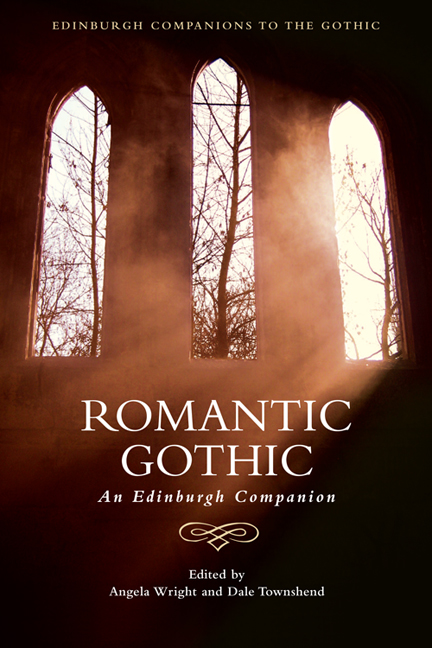Book contents
- Frontmatter
- Contents
- 1 Gothic and Romantic: An Historical Overview
- Part I Gothic Modes and Forms
- Part II National and International Borders
- 11 Gothic Borders: Scotland, Ireland and Wales
- 12 Gothic Travels
- 13 The Romantic and the Gothic in Europe: The Elementary Spirits in France and Germany as a Vehicle for the Transmission and Development of the Fantastique, 1772–1835
- 14 American Gothic Passages
- Part III Reading the Romantic Gothic
- Notes on Contributors
- Index
14 - American Gothic Passages
from Part II - National and International Borders
Published online by Cambridge University Press: 05 August 2016
- Frontmatter
- Contents
- 1 Gothic and Romantic: An Historical Overview
- Part I Gothic Modes and Forms
- Part II National and International Borders
- 11 Gothic Borders: Scotland, Ireland and Wales
- 12 Gothic Travels
- 13 The Romantic and the Gothic in Europe: The Elementary Spirits in France and Germany as a Vehicle for the Transmission and Development of the Fantastique, 1772–1835
- 14 American Gothic Passages
- Part III Reading the Romantic Gothic
- Notes on Contributors
- Index
Summary
There are terrible spirits, ghosts in the air of America.
D. H. Lawrence, Studies in Classic American Literature (Lawrence 1923: 85)At first glance, D. H. Lawrence's statement might strike the reader as grossly incongruous, even erroneous, in the case of America. This New Republic in a New World inhabited by a New Adam and devoid of a national history could not possibly be haunted. Jefferson's generation had ‘left behind the terror of Europe’ (Fiedler 1966: 31), explicitly pledging ‘to be done with ghosts and shadows, committed to live a life of yea-saying in a sunlit, neoclassical world’ (Fiedler 1966: 144). In their experimentation with the Gothic, numerous American writers in the Early Republic tended otherwise, restlessly probing that nation's fault-lines, in the process undermining the idealised rhetoric of ‘a utopia already achieved’ (Baudrillard 1986: 77) employed by many of their political leaders. Attentive to their post-Revolutionary transition from subjects to citizens, some of the Gothic's most adept American practitioners innovatively adapted that aesthetic for a New World context, bringing it to bear on such phenomena as popular democracy, the excesses of individualism, traditional social hierarchies and expanding capitalist enterprise, whilst extending the Gothic's critique of major Enlightenment tenets like natural goodness, human perfectibility, universal brotherhood, equality before the law and the primacy of reason and empiricism. Thus was the Gothic, an experimental literary aesthetic birthed alongside the American Revolution with which it shared ‘common origins in the turmoil of European thought in the late eighteenth century’ (Crow 2009: 15), manipulated to express and expose, contest and coalesce the nation's dreams and nightmares, its best examples evidencing the ‘deep vein of social criticism’ that Marilyn Butler deems characteristic of literature of the Romantic era (Butler 1981: 23). Particularly when viewed through the lens of ‘Dark Romanticism’, America, a quintessential Enlightenment experiment as characterised by thinkers like Thomas Jefferson and Alexis de Tocqueville, was exposed to be, as D. H. Lawrence's comments suggest, myopic and haunted, buttressed by darker deeds including ethnic cleansing and slavery, the latter ‘peculiar institution’ being pointedly described by Charles Brockden Brown, the godfather of American Gothic, as ‘the grandest and most cruel experiment that ever was tried upon human nature’ (Brown 1926a: 375).
- Type
- Chapter
- Information
- Romantic GothicAn Edinburgh Companion, pp. 267 - 286Publisher: Edinburgh University PressPrint publication year: 2015



